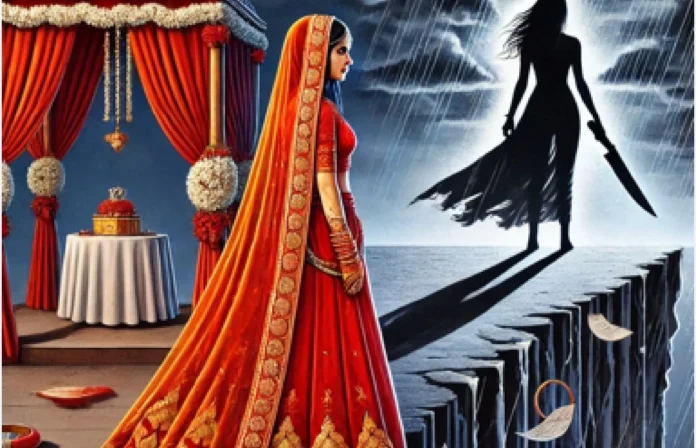By Dilip Bobb
Sonam Raghuvanshi told her parents about Raj, the man she was in love with, and they responded in classic Indian parental style: they forced her to marry someone else. Raj Kushwaha was their employee and it’s likely they took issue with his caste/economic status/skin colour/profession or any of the other social taboos that display many Indian parents’ disregard for their adult children’s hopes and dreams.
Sonam, 24, is now famous or infamous for having killed her newly-married husband Raja Raghuvanshi, while on their honeymoon in Shillong. During the investigation, it emerged that Sonam had hired alleged killers to kill Raja and throw his body into a gorge. A district and sessions court in Meghalaya sent Sonam and four others to police custody.
MOTIVE, MURDER, AND MISOGYNY
The evidence includes the murder weapon, bloodied clothing, CCTV footage and testimonies of locals who saw Sonam and Raj together. Once Raj was arrested, Sonam surrendered herself at a police station in Uttar Pradesh. It’s a tragedy that is now all too familiar.
Sonam lived in Indore’s Kushwah Nagar where, in her father’s words, her movements “were strictly curbed”. The man she was told to marry was virtually a stranger, matched by matrimonial and social norms in that level of society.
The political reaction after the case shows how deep-rooted caste and other social prejudices are. The BJP’s Madhya Pradesh Chief Minister Mohan Yadav stated that “letting children go so far” needed to be thought about. Another minister in his cabinet, Kailash Vijayvargiya added: “It’s a good thing to get your children educated, but they should also be taught culture. Children who don’t have culture become Sonam.”
THE DOMINO OF DEATH
A month earlier, a woman’s body was discovered in a gunny bag in Muzaffarnagar. The police identified her as Anita, killed by in-laws allegedly upset about her marriage. In Gujarat’s Gandhinagar, Payal conspired with her cousin to murder her husband Bhavik just four days after marriage. In another gruesome episode in Meerut, 25-year-old Saurabh Rajput, newly returned from London, was stabbed and entombed in cement by his wife Muskan and her lover.
LOVE, LUST AND LETHAL OUTCOMES
In March 2025, two weeks into her marriage, Pragati Yadav in Uttar Pradesh allegedly conspired with her lover to kill her husband. They hired a contract killer and paid him Rs two lakh. Dilip, the victim, succumbed to bullet wounds.
That same year saw a spree of violent spousal deaths across India—some for love, others for power or revenge. A woman in Bijnor strangled her husband for refusing to relocate. A man in Jaipur was set ablaze for confronting his wife about an affair. A Gurdwara sevadar in Haridwar was killed by his wife citing abuse.
PREMEDITATED PASSION
Matrimonial advisers warn of a toxic mix of betrayal, obsession, and desperation. Many of the suspects were entangled in forbidden affairs. In Sonam and Muskan’s cases, their lovers were also the alleged masterminds.
One particularly disturbing case in Bareilly involved Aarti, 25, who was sentenced to life for killing her husband with the help of her 17-year-old lover. The affair had begun over social media. The judge in his ruling remarked: “Calling the relationship between Aarti and her minor boyfriend as love will be an insult to such a sanctioned feeling.”
LAW, AUTONOMY AND LEGAL GAPS
While parental consent isn’t legally required for a valid marriage under the Special Marriage Act, outdated traditions still dominate, rendering choice a battleground. In May 2024, the Supreme Court noted the abuse of Section 498A (cruelty by husband) and suggested the need for balance and introspection.
A landmark Allahabad High Court ruling said the Hindu Marriage Act needed modern amendments.“The manner in which marriages take place now was unheard of when the Act was passed in 1955,” it noted, citing social change due to education, westernisation, and financial independence.
MURDER BY CALCULATION
Unlike crimes of passion, these murders were plotted, often in cold detail. Shivani of Bijnor, for example, sedated and then strangled her husband before walking police through each step. Investigators say isolated settings—like a honeymoon in the Northeast—often serve as cover for the final act.
Until recently, wives were rarely cast as perpetrators. The 1989 case of Kiranjit Ahluwalia in the UK became iconic: she killed her abusive husband after years of torture and had her conviction reduced. But in India, female-on-male spousal murder was virtually absent from national headlines until after 2020.
CRACKS IN THE SACRED INSTITUTION
Back in 2019, the Indian Journal of Community Medicine revealed that over 50 percent of men surveyed had faced some form of partner violence. The pattern is not symmetrical, but it exists—often hidden, often minimised.
What do these murders suggest about Indian marriage today? Patriarchal customs leave many women with no exit route. Divorce is still stigmatised. Love is policed. The autonomy of a married woman is often buried under family pressures and rigid gender roles.
UNCOMFORTABLE TRUTHS
Sonam’s brother disowned her in front of the murdered husband’s family, calling her actions unforgivable. But her story—and others like hers—hold up a mirror to a society still caught between modern aspirations and medieval controls.
“To every action, there is an equal reaction,” said the Allahabad High Court. And in some cases, that reaction is deadly.
—The writer is former Senior Managing Editor, India Legal magazine


